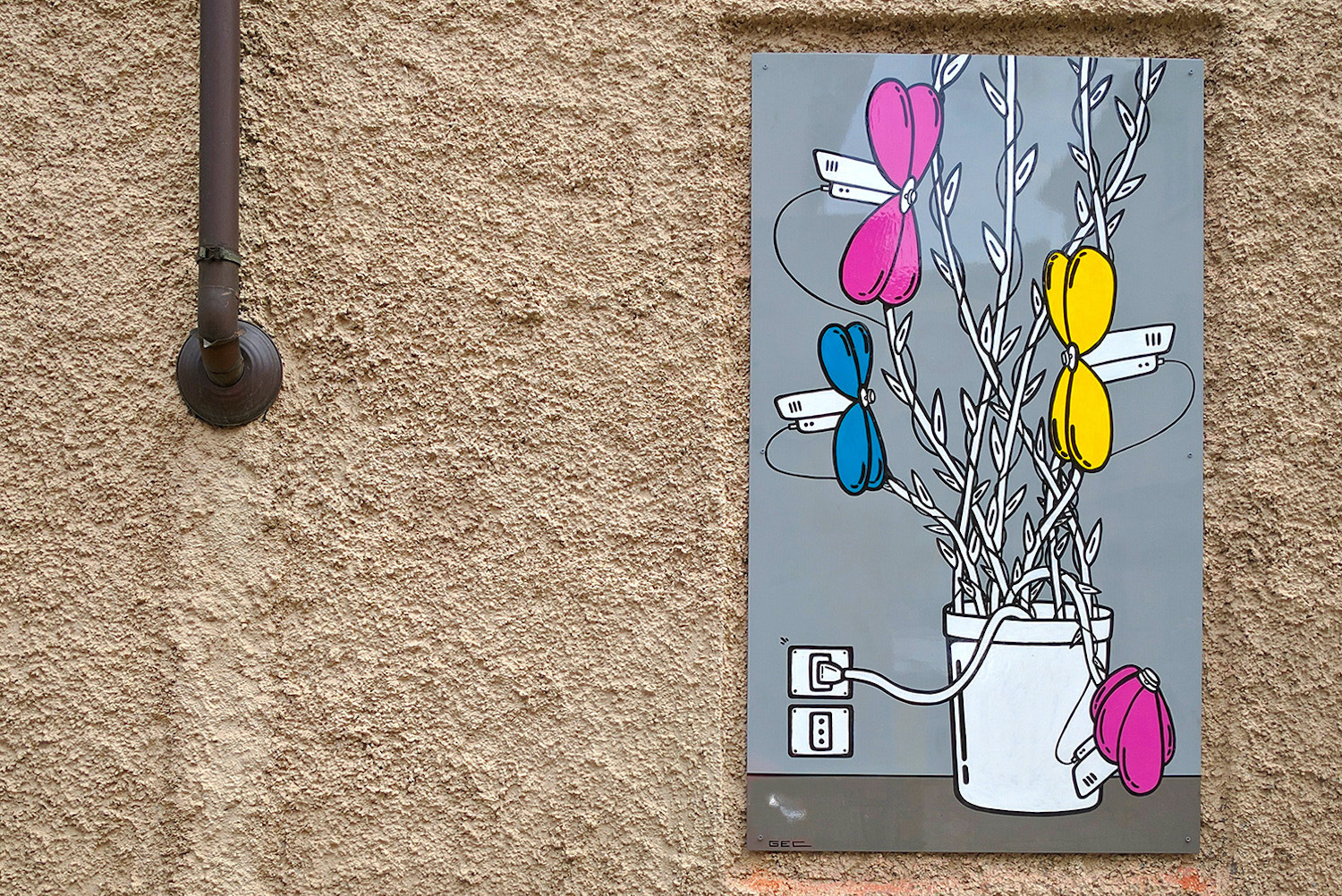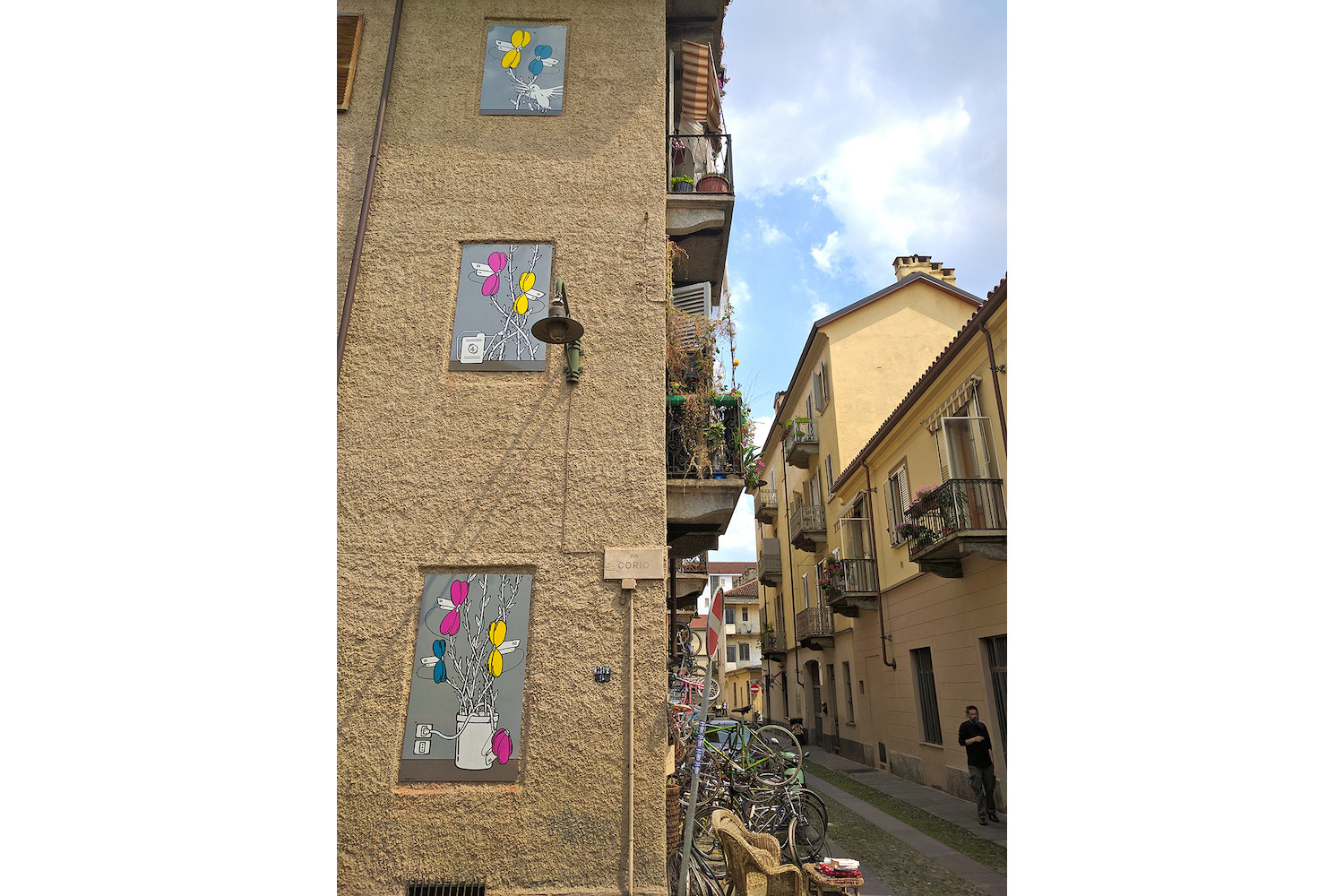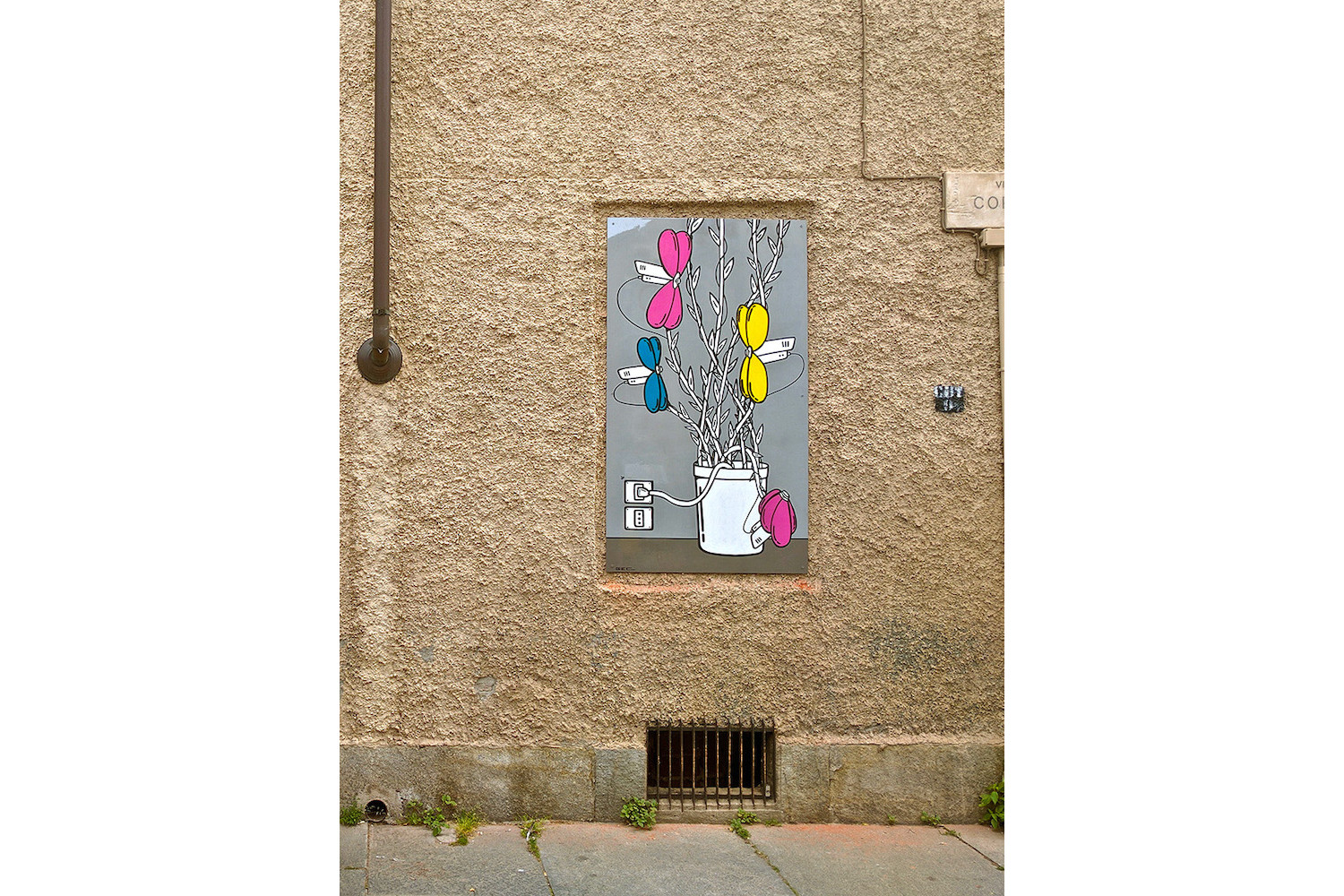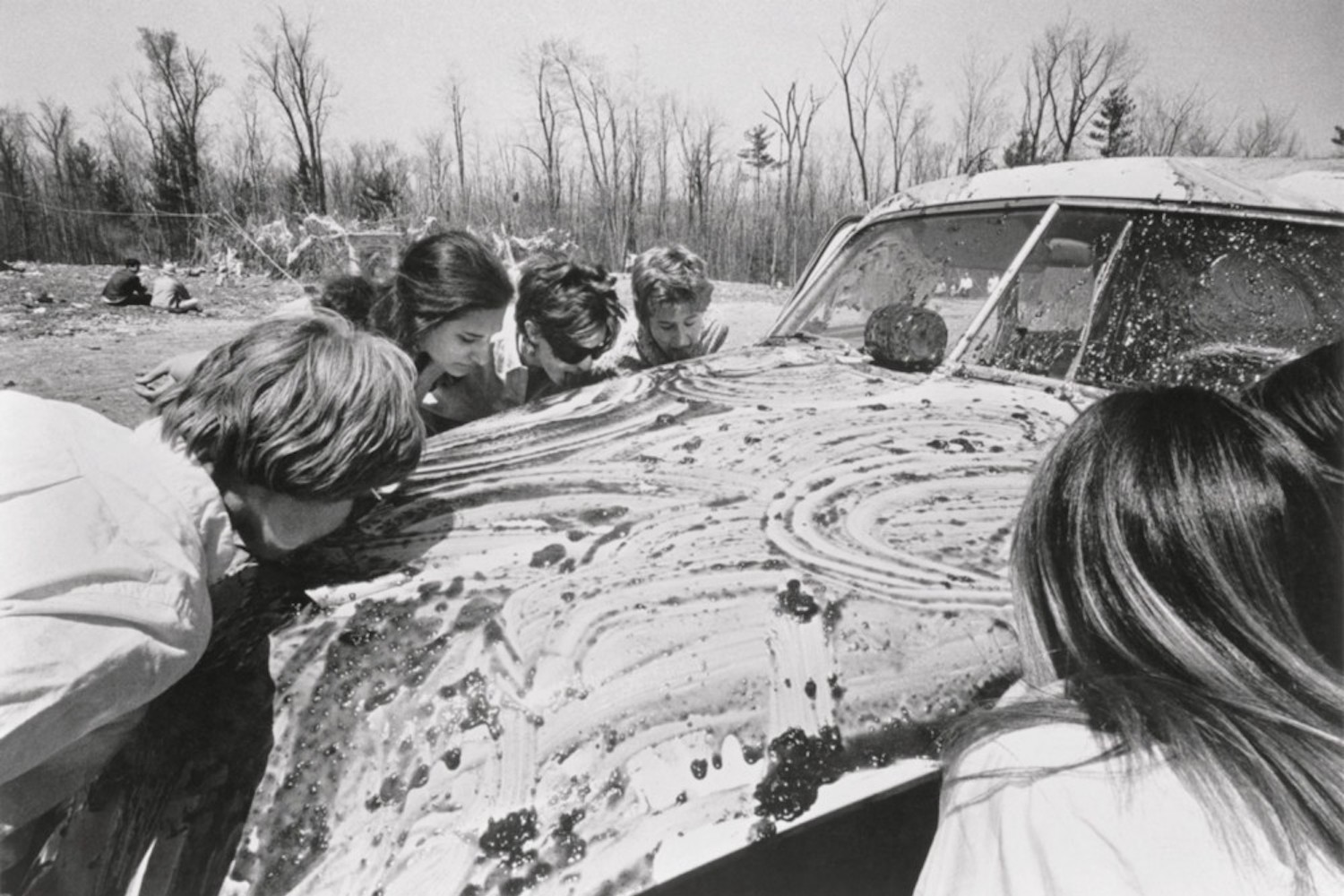“Public Art 2666” is a column that seeks to explore the interaction between the public domain and contemporary artistic practices, giving particular consideration to the resulting social impacts. The research is run by Collettivo 2666.

Sistema floreale di videosorveglianza (2016) by artist Gec depicts a curious hybrid: houseplants with video cameras for flowers.
Displayed in Torino’s Museum of Urban Art, the first open air contemporary art museum in an Italian urban center, the work may be interpreted as posing a set of questions different from those asked by recent nature and plant themed exhibitions in relation to the natural world.
In his review of Daniel Steegman Mangrané‘s multimedia exhibition at the Pirelli Hangar Bicocca entitled “A Leaf-Shaped Animal Draws The Hand” (2019), Vincenzo Di Rosa writes that it inspires a desire for “hybrid collision” between the visitors, “modern subjects” (a term historically exemplified by the urban dweller) and “dato organico” (a term that translates as an unquantifiable organic unit that in any case seemingly excludes the notion of life) precisely because it makes us aware of the divide between them. Through the various media – including drawing, photography, holography and film – that mostly though not exclusively display plants, the emphasis is placed on how we are “disqualified” from the natural realm.1 The origin of the English word “screen” is particularly evident in this context – derived from words for the screen placed over a fire to contain sparks – a barrier.
Among the speakers at Foreste Plurali, a conference organized in honour of Mangrané’s exhibition, was philosopher Emanuele Coccia. His most recent book, The Life of Plants, originally published the same year Gec’s piece was unveiled, offers a different conception of the dynamic between ourselves, the media we use and the organic realm previously considered lifeless and therefore mostly ignored that we see as embodied by Sistema floreale di videosorveglianza and the figure of the plant cyborg that it contains which excludes the modern subject and any display or screen of any kind, containing simply video cameras (the active part of the video apparatus) attached to plants.

Coccia argues for a reversal of our self-reflexive attitude towards life, whereby because we are inclined to identify with ourselves we have been the object of philosophical inquiry while we have rarely investigated plants, considered mere “inane ornaments of the decoration of the modern metropolis” (p.11)2. He writes of the role of plants that, “as the very creator of atmosphere”3, occupy the fundamental position from which we should analyze all elements of life.
The book’s chapters are divided into sections titled as various theories – given that the word theory is etymologically related to that of theater and the act of spectating, a theory of plants could be said to be an invitation to adopt their point of view. Coccia is clear there is a visual element, not in the literal way that the presence of video cameras in Gec’s piece suggests (considering that the word video also evokes the act of seeing, coming from the Latin “I see”)4, but in an abstract sense whereby plants see the world its most “ancestral” form, in only its most elementary components: the rocks, the water, the air, the light” (p.18).
In this way, whereby the great chain of being has been reconceptualized to have us, representative of organic life, living in the world plants created and continute to create, the distinction between us lies in the fact that we do not have unmediated, direct relationships with the lifeless, inorganic world – that is, the elements – whereas plants absorb them directly, actively turning them into the atmosphere which we then breathe. In short, we require the mediation of plants to exist with the world.
What Gec’s piece reminds us is that similarly, in today’s world, we require the mediation of video. Perhaps it is the case that the more our experiences are mediated, the easier it is to engage with the lifeless, organic world, not limited to the sense of the ease of access to images of plants on a screen but in a metaphysical sense. In this lies the enigma: that the fundamental position from which we should analyze all elements of life is therefore not from the position of self-reference, as we are used to, philosophically contemplating only ourselves, but from the plants position as “the only breach open in the self referentiality of the living” (p.17). We may read Gec’s piece as suggesting that if we can now think about plants philosophically it is because of (video) media, not because we are in the midst of a return to nature as solace in the face on an impending Anthropocene.

Because it is a work of art featuring video cameras, Sistema floreale di videosorveglianza evokes the history and theory of video’s use in the artworld, its position as the “reflexive medium” as Yvonne Spielmann has called it. Given that plants represent a break in our self-reflexivity, Gec’s work encapsulates an inflection point between two of the earliest and most prominent uses of video: the closed circuit in the gallery, critiqued for example by Allan Kaprow in his 1974 essay Video Art: Old Wine, New Bottle, and the accessible network of counterinformation produced and broadcast directly from one user to another, as idealized by, for example, Roberto Faenza’s manual Senza chiedere permesso. Come rivoluzionare l’informazione (1973). Both of these approaches to using video in its early years sought to explore the relational potential of the medium, resisting the skewed power dynamic of surveillance evoked by Gec’s title.
Regarding the first of these uses, namely the closed circuit, it is significant that the plants in the lowest panel of the work seem to be recording themselves, as early video artists did, using the video apparatus (monitor included) as another instrument with which people recognize themselves, like in a mirror. Indeed, this seeming obsession with the visitors as well as the artists’ reflection (for example, in tapes such as Joan Jonas’ 1972 Vertical Roll), was such to lead Rosalind Krauss to deem the entire genre of video art as characterized by an “aesthetics of narcissism”, a concept indeed worth revisiting when we consider the 2014 entrance of the word selfie into the English dictionary.5
The concept of narcissism being characteristic of our expanding use of video (now including/as social media) is especially significant when you consider Gec’s proposition as the video camera as a flower, the plant’s reproductive structure, pointing at itself. In the section Theory of the flower, Coccia argues that flowers’ goal in reproducing is not reduced to a simple duplication of self (p.128)6. For the flower, reproduction is not an instrument of individual narcissism but an ecology of “mixture whereby the individual makes the world and the whole world then gives birth to the new individual” (p.127). Moreover, while the drive for animal life to reproduce is based on and motivates movement, Coccia’s plants stay still, rooted to one place (p.125).

As we have grown increasingly dependent on video, perhaps we have likewise become static “attractors”, rather than narcissists.7 Like flowers creating the atmosphere, we are also continually creating the videosphere,8 in turn attracting the elements of it that are of interest to us at any given time to ourselves. Plants, we now know, communicate through the diffusion of volatile chemicals and likewise, we broadcast through video/social media, with our digital lives sprouting in a myriad of communicative forms with our bodies rooted in the physical world. With this in mind it is also significant that Gec’s piece depicts a houseplant9, dependent on a distinction between our domestic space and the public sphere, something more distinct perhaps in the last months more than ever before for many people across the globe.
As Mario Perniola has written, the more we use video the less we become a “society of the image”; rather, we begin to experience the world as things ourselves10. While this has often been encapsulated by the metaphor of the human cyborg, which suggests that we are becoming decreasingly organic, the plant cyborg recording itself in Gec’s piece is a more provocative and insightful metaphor for understanding “the chimerical”11 nature of virtual realities, because it suggests to us that the key question is not a “disqualification” of the subject from nature but a break with subjectivity itself through the feeling of ourselves as a medium, an in-between.12
Although perhaps to identify with this figure is an ironic continuation of typical narcissism and the need to recognize ourselves, we merely mean to suggest that rethinking discussions around our increased interest in plants in art can be done alongside discussions of our growing use of video media to both of their benefits.13 The enigma of our current state lies in our need to be one with nature as we become increasingly digital, and Gec’s piece suggests that, at least in theory, we are already doing so.14
Perhaps, then, we should conclude by remembering that in some versions, Ovid’s Narcissus myth ends with the person turning into a flowering plant.


